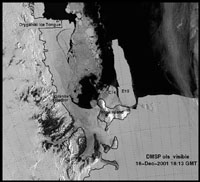|
Blowing
in the Wind
|

|
Nature's
Icebreaker
by Paul Doherty
December
20 , 2001
The
old Antarctic hands play many jokes on newcomers. In 50-mile-per-hour
(80 kph) storm winds, I faced downwind, then laid back, allowing
the air to hold me up. This is called "leaning on the
wind." One geologist saw me doing this and immediately
walked behind me, "stealing my wind" and causing
me to stagger around. He did this twice before I figured out
what was going on.
Out
on the ice, meanwhile, the winds were 100 mph (160 kph). When
the speed of the wind doubles, the force the wind exerts on
any object, like a human body, quadruples! At 120 mph (190
kph), the force of the wind is equal to the force of gravity,
and humans can fly, whether they want to or not.
Here
at McMurdo Station on Ross Island there is a giant iceberg
named B-15 stealing our wind and ocean currents. It is 100
miles (160 km) long and 20 miles (30 km) wide, just about
the size of the San Francisco peninsula. It stands 150 feet
(50 m) above the ocean, and from what we know about icebergs,
this means it extends 1500 feet (500 m) deep into the ocean.
Some people wondered whether it was anchored to the bottom
or not. In addition, because B-15 blocked the ocean currents
last year, the sea ice never left the vicinity of McMurdo,
and the icebreaker that clears the way for the all-important
Greenwave supply ship had to cut a longer channel through
the ice. This year there was so much ice that the Coast Guard
sent two icebreakers.
|
|

|
|

|
After
the storm, the iceberg has rotated, and the sea ice has
broken and blown away.
Click
to enlarge.
|

|
|
|
|

|
Then
came the storm.
The
old hands said it was the worst December storm in memory.
The images from the weather satellite told an amazing tale.
The 100+ mph winds pushed so hard on iceberg B-15 that it
rotated around like the hour hand on a clock running backward.
This answered the question about whether it was hitting the
bottom or not: It was floating. The wind also broke up and
blew out a 30-mile-diameter region of sea ice. The coast guard
will have to do less work, thanks to the winds of December.
Now
that I've been through my first storm, I'm beginning to feel
like an old Antarctic hand myself. If I see anyone leaning
on the wind, I know exactly what to do.
|

